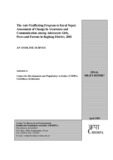Please use this identifier to cite or link to this item:
https://hdl.handle.net/20.500.14356/529Full metadata record
| DC Field | Value | Language |
|---|---|---|
| dc.contributor.author | Center for Research on Environment Health and Population Activities (CREHPA | |
| dc.date.accessioned | 2013-01-11T05:24:16Z | |
| dc.date.accessioned | 2022-11-08T10:15:57Z | - |
| dc.date.available | 2013-01-11T05:24:16Z | |
| dc.date.available | 2022-11-08T10:15:57Z | - |
| dc.date.issued | 2003 | |
| dc.identifier.uri | http://103.69.126.140:8080/handle/20.500.14356/529 | - |
| dc.description | In recent years, millions of women and girls have been trafficked across national borde and within countries. The global trafficking industry generates an estimated US$5 to billion each year, more than the profits generated by the arms and narcotics trade (Widgren 1994). Over the last decade, the growing trafficking problem in South Asia h been particularly acute in Nepal, one of the least developed countries in the world, wit 42 percent of its citizens living below the poverty line. While there are no reliable data on the magnitude of the trafficking problem in Nepal, th most widely quoted sources estimate that 5,000 to 7,000 girls are trafficked from Nepal India and other neighbouring countries every year, primarily for prostitution: 200,00 Nepali girls and women currently are working in the sex industry in India (UNIFEM 1998, UNICEF 1997). Another study postulates that 20,000 minors are brought into Ind from Nepal for sex work every year (Haemeed 1997). The occurrence of trafficking in Nepal is generally attributed to widespread poverty, lac of female education, low status of girls and women and social disparities rooted in ethn and caste groupings. Women living in an environment of restricted rights and limite personal freedom with few employment opportunities may decide that out-migration their only hope for achieving economic independence and a higher standard of living Those who are victimized by traffickers experience abuse, exploitation and greate vulnerability to human immunodeficiency virus/acquired immune deficiency syndrom (HIV/AIDS) and other sexually transmitted infections (STIs). | en_US |
| dc.language.iso | en_US | en_US |
| dc.subject | Anti-Trafficking Program | en_US |
| dc.title | The Anti-Trafficking Program in Rural Nepal: Assessment of Change in Awareness and Communication among Adolescent Girls, Peers and Parents in Baglung District, 2002 | en_US |
| dc.type | Technical Report | en_US |
| Appears in Collections: | Post Graduate Grant (PG) Reports | |
Items in DSpace are protected by copyright, with all rights reserved, unless otherwise indicated.

